


9.5. HII Regions in Ringed Galaxies
The previous section showed that colors of nuclear, inner, and outer
rings indicate that such features are usually sites of active star
formation, particularly the inner and nuclear types. It is therefore
not surprising that rings are also often concentrations of HII regions
(see Figure 41).
Van der Kruit (1976b)
showed that the inner ring of NGC 4736 is an intense bounded zone of both
discrete HII regions and diffuse H emission. In NGC 3351,
Rubin et al. (1975) and
Peterson et al. (1976)
found that
HII regions are concentrated within the nuclear ring, the bright inner
ring, and the outer arms, but that there was little emission from the
region between the nuclear and inner rings. The same was found for the
inner and nuclear rings of NGC 5728 by
Rubin (1980).
emission. In NGC 3351,
Rubin et al. (1975) and
Peterson et al. (1976)
found that
HII regions are concentrated within the nuclear ring, the bright inner
ring, and the outer arms, but that there was little emission from the
region between the nuclear and inner rings. The same was found for the
inner and nuclear rings of NGC 5728 by
Rubin (1980).
Buta (1984)
obtained HII region distributions in 8 ringed galaxies:
NGC 1433, 1512, 3351, 4725, 4736, 5364, 6300, and 7531, based on both
spectroscopy and Fabry-Perot interferometry. In the five barred spirals
(NGC 1433, 1512, 3351, 4725, and 6300) of the sample, the bar regions
were largely devoid of discrete HII regions, although NGC 6300 was
found to have diffuse H emission in its bar region. In each
case, emission is concentrated in the inner ring regions or beyond, and
in a nuclear ring in three cases. In the two weakly-barred sample
objects (NGC 4736 and 7531), the inner rings are very intense sources
of H
emission in its bar region. In each
case, emission is concentrated in the inner ring regions or beyond, and
in a nuclear ring in three cases. In the two weakly-barred sample
objects (NGC 4736 and 7531), the inner rings are very intense sources
of H emission and HII
regions, and are the brightest regions in
H
emission and HII
regions, and are the brightest regions in
H in their respective
galaxies. Diffuse emission fills the
entire region interior to the inner ring of NGC 7531. In the one true
nonbarred case, NGC 5364, the inner ring includes HII regions, but
is not the strongest source of emission in the galaxy.
in their respective
galaxies. Diffuse emission fills the
entire region interior to the inner ring of NGC 7531. In the one true
nonbarred case, NGC 5364, the inner ring includes HII regions, but
is not the strongest source of emission in the galaxy.
Detector technology has improved since these early studies, and many
more ringed galaxies have been imaged in H or H
or H +[NII],
usually as parts of other studies. For example, imaging Fabry-Perot
interferometry revealed a small nuclear ring of H
+[NII],
usually as parts of other studies. For example, imaging Fabry-Perot
interferometry revealed a small nuclear ring of H emission in
the grand design spiral NGC 4321
(Arsenault et al. 1988).
This small
feature is actually a spiral in broad-band images.
Pogge (1989)
imaged the ionized gas in 91 nearby non-Seyfert galaxies, and discovered a
wide variety of nuclear emission morphologies. Inner rings or
pseudorings were prominent in NGC 4736 and 5921, while bright nuclear
rings of emission were detected in 13 galaxies ranging from distinct
rings to partial rings with ``hotspots''. Pogge found that the relative
contribution of such rings to the total H
emission in
the grand design spiral NGC 4321
(Arsenault et al. 1988).
This small
feature is actually a spiral in broad-band images.
Pogge (1989)
imaged the ionized gas in 91 nearby non-Seyfert galaxies, and discovered a
wide variety of nuclear emission morphologies. Inner rings or
pseudorings were prominent in NGC 4736 and 5921, while bright nuclear
rings of emission were detected in 13 galaxies ranging from distinct
rings to partial rings with ``hotspots''. Pogge found that the relative
contribution of such rings to the total H +[NII] luminosity
ranged from 1% in NGC 4254 to 94% in NGC 4314, and that the rings may
or may not surround a nuclear emission source. This study also
underscored once again the tendency for the interior regions of some
inner rings (e.g., in NGC 4736 and 5921) to be relatively devoid of
emission except for the nucleus.
+[NII] luminosity
ranged from 1% in NGC 4254 to 94% in NGC 4314, and that the rings may
or may not surround a nuclear emission source. This study also
underscored once again the tendency for the interior regions of some
inner rings (e.g., in NGC 4736 and 5921) to be relatively devoid of
emission except for the nucleus.
Ryder & Dopita (1993)
carried out an H imaging survey of
bright southern galaxies which included several inner-ringed galaxies:
NGC 1187, 1398, 6300, 5643, and 6744. They suggested that there may
be a reciprocal relationship between the number of HII regions in a bar
and the number in the inner ring, such that when the inner ring is
well-populated with HII regions, the bar region is devoid of HII
regions. The one outer-ringed galaxy in their sample, NGC 2217, showed
HII regions only in parts of the outer ring.
imaging survey of
bright southern galaxies which included several inner-ringed galaxies:
NGC 1187, 1398, 6300, 5643, and 6744. They suggested that there may
be a reciprocal relationship between the number of HII regions in a bar
and the number in the inner ring, such that when the inner ring is
well-populated with HII regions, the bar region is devoid of HII
regions. The one outer-ringed galaxy in their sample, NGC 2217, showed
HII regions only in parts of the outer ring.
Pogge & Eskridge
(1993)
found from another imaging survey that the
most common HII region distribution in S0 galaxies is an HII
ring. Though they refer to the observed rings only as ``inner'' or
``outer'' types, it is clear that conventional nuclear, inner, and
outer rings are represented. The most interesting H map in this
paper is for NGC 7742, a face-on example of a ringed SA galaxy
(see Figure 42). Just as for barred galaxies, the
inner ring is
a strong concentration of HII regions. In their sample, the inner and
nuclear rings tend to be fully populated in azimuth by HII regions, but
they note that the outer rings are more sparsely populated and patchy.
It is possible that some of these ``gas-rich'' S0's are probably
early-type spirals (i.e., misclassified S0/a types).
map in this
paper is for NGC 7742, a face-on example of a ringed SA galaxy
(see Figure 42). Just as for barred galaxies, the
inner ring is
a strong concentration of HII regions. In their sample, the inner and
nuclear rings tend to be fully populated in azimuth by HII regions, but
they note that the outer rings are more sparsely populated and patchy.
It is possible that some of these ``gas-rich'' S0's are probably
early-type spirals (i.e., misclassified S0/a types).
Phillips (1993a;
see also
Kennicutt 1994 and
Phillips 1996)
surveyed the
distribution of HII regions in a sample of SBb and SBc galaxies. The
tendency for the bar regions of SBb galaxies to be devoid of HII
regions was again noted, as well as the frequent presence of
circumnuclear rings of ionized gas. He also compared the luminosity
function of HII regions in inner pseudorings with that in the outer
disk of a few galaxies. The outer disk HII regions in NGC 1300 have a
standard Type I luminosity function with no break (see
Kennicutt et al. 1989),
while the inner pseudoring (arms enveloping the
bar in this case) appears to show a Type II luminosity function with a
break, perhaps implying an upper limit to the masses of giant molecular
clouds allowed in that region. Phillips also found circumnuclear star
formation to be common in SBb galaxies: eleven of twelve SBb galaxies
in his sample of RSA spirals include such emission.
From an H survey of 52
RSA barred spirals,
Garcia-Baretto et
al. (1996)
found nuclear ionized gas rings in 10 galaxies, three of
type SBa, six of type SBb, and one of type SBbc. Their sample was
chosen to have IRAS colors indicative of star formation and high dust
temperatures. Most of the nuclear emission rings they identified were
found to be misaligned with the primary bar.
survey of 52
RSA barred spirals,
Garcia-Baretto et
al. (1996)
found nuclear ionized gas rings in 10 galaxies, three of
type SBa, six of type SBb, and one of type SBbc. Their sample was
chosen to have IRAS colors indicative of star formation and high dust
temperatures. Most of the nuclear emission rings they identified were
found to be misaligned with the primary bar.
The most detailed study of the HII region distribution in ringed
galaxies has been made by Crocker, Baugus, and Buta
(1996, hereafter
CBB). This study included H +[NII] images of 32 galaxies from
the CSRG. Besides verifying the results from previous studies,
CBB were
able to investigate connections between HII region distributions and
dynamics. The main results from the paper are as follows:
+[NII] images of 32 galaxies from
the CSRG. Besides verifying the results from previous studies,
CBB were
able to investigate connections between HII region distributions and
dynamics. The main results from the paper are as follows:
Figure 43. Distributions of HII regions in
barred galaxy inner rings of
different intrinsic shapes: NGC 6782 (left), an example of an extremely
oval inner ring (continuum axis ratio qC = 0.69), and
NGC 7329 (right), an example of a nearly circular
inner ring
(qC = 0.94). Both images are deprojected according to
parameters in
Crocker et al. (1996)
and have been rotated so
that the bar axis is horizontal.

| 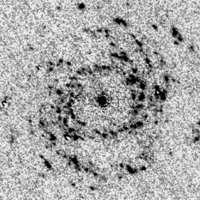
|
- The distribution of HII regions around inner rings is
sensitive to the intrinsic shape of the ring. Extremely oval inner
rings tend to have HII regions ``bunched up'' near the intrinsic ring
major axis (see Figure 43, left), while more
circular rings tend to have a more even distribution of HII regions with
azimuth (see Figure 43, right). The effect is
quantified in Figure 44 via Fourier analysis
for 18 galaxies whose
deprojected continuum ring axis ratios (qC) range from
0.6 to nearly 1.0. A definite correlation is in evidence with the
relative 2
 Fourier amplitude F increasing with decreasing
qC. The dynamical
implication of this result is that gas gathered into the rings moves
along oval streamlines, and that the material slows down in the
rotating reference frame near the ring major axis. This argues that
inner rings lie within the corotation resonance according to
Contopoulos (1979).
Fourier amplitude F increasing with decreasing
qC. The dynamical
implication of this result is that gas gathered into the rings moves
along oval streamlines, and that the material slows down in the
rotating reference frame near the ring major axis. This argues that
inner rings lie within the corotation resonance according to
Contopoulos (1979).
Figure 44. Quantification of distribution
of HII regions around inner rings and the intrinsic shape of the
ring. F is the relative 2 Fourier amplitude of the H
Fourier amplitude of the H + [NII] emission around
the ring, and qC is the deprojected continuum ring
axis ratio. From Crocker et al. (1996).
+ [NII] emission around
the ring, and qC is the deprojected continuum ring
axis ratio. From Crocker et al. (1996).
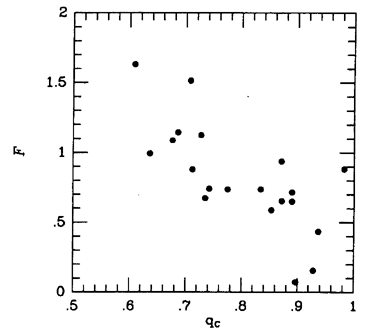
|
- In several galaxies where the red continuum image shows a broad,
diffuse stellar outer ring of type R1, the HII regions follow what
appears to be an R'2 pseudoring pattern. This was seen in
NGC 1326 (see Figure 45),
NGC 6782, IC 1438,
and UGC 12646.
The dichotomy suggests that in these galaxies, the R1 component
formed first and lasted long enough to leave a stellar remnant. The gas
distribution has now evolved into the R'2 phase, a sequence
demonstrated by the test-particle models of Byrd et al.
(1994; see
section 12.2).
Figure 45. Distribution of HII regions in
NGC 1326, showing broad stellar outer R1
ring in red
continuum (left) and partial R'2 outer pseudoring in H + [NII] (right),
from Crocker et
al. (1996).
The HII regions in the outer
arms do not line the R1 feature but are displaced to
the outside edge of this ring. This galaxy also illustrates the co-existence
an old population R1 ring and a star-forming nuclear ring
(overexposed center).
+ [NII] (right),
from Crocker et
al. (1996).
The HII regions in the outer
arms do not line the R1 feature but are displaced to
the outside edge of this ring. This galaxy also illustrates the co-existence
an old population R1 ring and a star-forming nuclear ring
(overexposed center).
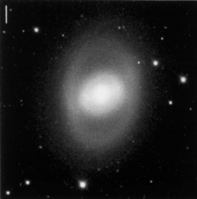
| 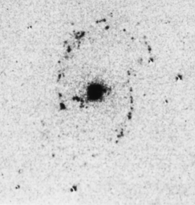
|
- Nuclear ring morphology shows an even greater range than found by
Pogge (1989).
In the nearly face-on galaxy NGC 1317,
CBB found that
most of the HII regions are distributed in a double nuclear
ring/pseudoring pattern. The inner nuclear ring is aligned parallel to
a strong secondary bar, while the outer nuclear pseudoring is aligned
parallel to a broad primary bar which itself is aligned perpendicular
to the secondary bar (see
Schweizer 1980).
This links the double nuclear ring feature to an outer ILR.
- HII region luminosity functions in ringed galaxies can be represented
by power laws whose exponents are very similar to those found for
non-ringed galaxies. In a few cases, a luminous nuclear ring produces
a secondary peak in the luminosity function.
- An unusual H
 distribution was found in the large outer-ringed
galaxy NGC 1291. The primary bar, lens, and secondary bar
regions of
this galaxy are filled with a wispy pattern of diffuse ionized gas
very reminiscent of what is seen in the bulge of M31
(Ciardullo et al. 1988)
and M81
(Devereux et al. 1995).
distribution was found in the large outer-ringed
galaxy NGC 1291. The primary bar, lens, and secondary bar
regions of
this galaxy are filled with a wispy pattern of diffuse ionized gas
very reminiscent of what is seen in the bulge of M31
(Ciardullo et al. 1988)
and M81
(Devereux et al. 1995).
Finally, we note the existence of HII regions connected with the subtle
``dimpling'' aspect of R'1 outer pseudorings in some
galaxies. This has been noted in a study of the
(R'1)SAB(rs)a spiral IC 4214 by
Buta et al. (1996).
Their H distribution (based on
Fabry-Perot interferometry) is shown in
Figure 46, and the arrows point to HII regions
connected with weak dimples seen in blue light. These dimples are
regions where the gas would be slowing down in the bar reference frame
(Schwarz 1981),
and perhaps bright HII regions might be expected in such
regions depending on the gas available. This is yet another aspect of
the distribution of HII regions in ringed galaxies which can be
connected to internal dynamics. IC 4214 is also discussed by
Buta & Crocker (1991)
and Saraiva (1996).
distribution (based on
Fabry-Perot interferometry) is shown in
Figure 46, and the arrows point to HII regions
connected with weak dimples seen in blue light. These dimples are
regions where the gas would be slowing down in the bar reference frame
(Schwarz 1981),
and perhaps bright HII regions might be expected in such
regions depending on the gas available. This is yet another aspect of
the distribution of HII regions in ringed galaxies which can be
connected to internal dynamics. IC 4214 is also discussed by
Buta & Crocker (1991)
and Saraiva (1996).
Figure 46. Dimple HII regions in IC 4214 (arrows).
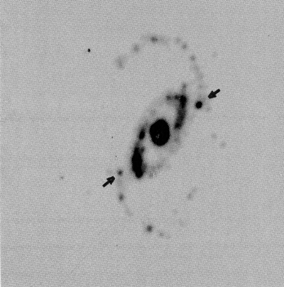
|
Nuclear Hotspots
A special topic in HII regions in ringed galaxies concerns the nature
of nuclear ``hotspot'' HII regions compared to HII regions away from
the nucleus. These hotspots are commonly found in nuclear rings, as
we have noted.
Kennicutt, Keel, and
Blaha (1989)
have made a
spectrophotometric and radio continuum comparison between nuclei,
hotspot, and disk HII regions to determine the mechanisms responsible
for the ionization and the validity of assumptions concerning abundance
determinations. These authors first of all determined that many of
the hotspots seen in the nuclear rings are not HII regions but are
continuum knots, i.e., star clusters or associations with no surrounding
ionized cloud. The luminosities of disk HII regions and hotspot HII
regions were found to be similar, but the hotspot HII regions were
found to be more compact and had H equivalent widths 7 times
lower than disk HII regions of comparable luminosity (see also
McCall et al. 1985 and
Mayya 1994).
The stellar
continua in the hotspots were also found to be more significant
than in disk HII regions. Kennicutt et al. suggested that the optical
and radio continuum properties of these regions are not easily
explained in a simple picture whereby the hotspots are normal,
photoionized HII regions located in an unusual environment.
equivalent widths 7 times
lower than disk HII regions of comparable luminosity (see also
McCall et al. 1985 and
Mayya 1994).
The stellar
continua in the hotspots were also found to be more significant
than in disk HII regions. Kennicutt et al. suggested that the optical
and radio continuum properties of these regions are not easily
explained in a simple picture whereby the hotspots are normal,
photoionized HII regions located in an unusual environment.
Korchagin et al. (1995)
have examined the star formation mechanism in
hotspots. The most favored idea is that the high continuum emission
reflects an accumulation of stars over many generations, so that star
formation has to take place in hotspots over a period of time longer
than the normal lifetime of a disk HII region. They conclude that
hotspots are regions of self-regulated star formation where ultraviolet
radiation from young, massive stars both triggers star formation and
regulates it. The unique conditions at the centers of galaxies help to
explain the behavior of the mechanism as compared to ordinary HII
regions in the outer disk regions. Korchagin et al. conclude that the
low equivalent widths and red optical colors of hotspots rule out an
instantaneous burst interpretation but favor self-regulated sequential
star formation lasting for 10-70 million years.



 emission. In NGC 3351,
Rubin et al. (1975) and
Peterson et al. (1976)
found that
HII regions are concentrated within the nuclear ring, the bright inner
ring, and the outer arms, but that there was little emission from the
region between the nuclear and inner rings. The same was found for the
inner and nuclear rings of NGC 5728 by
Rubin (1980).
emission. In NGC 3351,
Rubin et al. (1975) and
Peterson et al. (1976)
found that
HII regions are concentrated within the nuclear ring, the bright inner
ring, and the outer arms, but that there was little emission from the
region between the nuclear and inner rings. The same was found for the
inner and nuclear rings of NGC 5728 by
Rubin (1980).



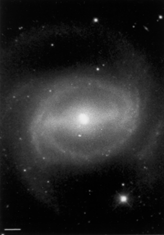
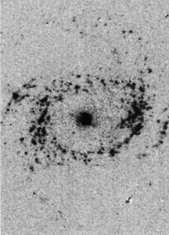
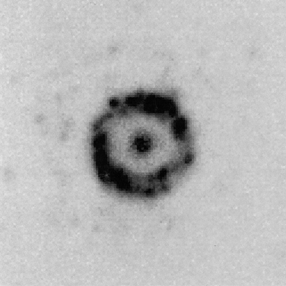


 Fourier amplitude F increasing with decreasing
qC. The dynamical
implication of this result is that gas gathered into the rings moves
along oval streamlines, and that the material slows down in the
rotating reference frame near the ring major axis. This argues that
inner rings lie within the corotation resonance according to
Fourier amplitude F increasing with decreasing
qC. The dynamical
implication of this result is that gas gathered into the rings moves
along oval streamlines, and that the material slows down in the
rotating reference frame near the ring major axis. This argues that
inner rings lie within the corotation resonance according to



